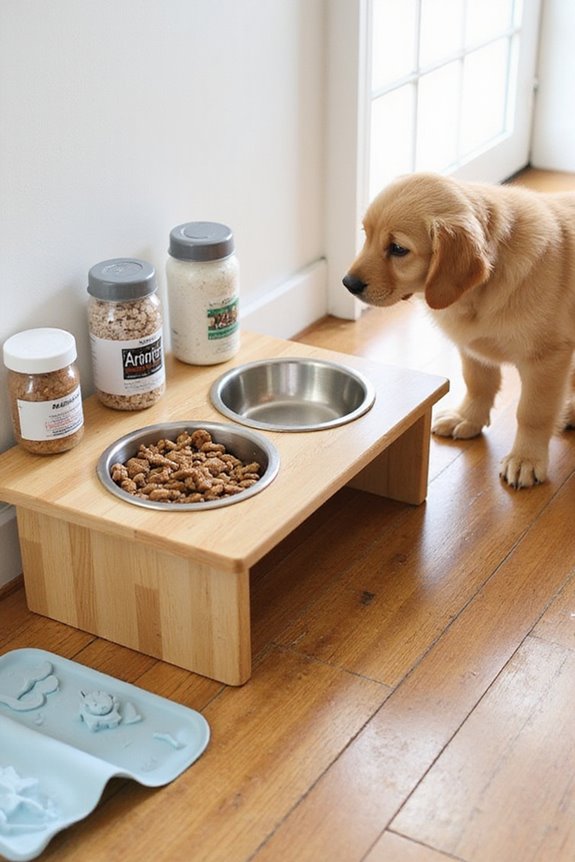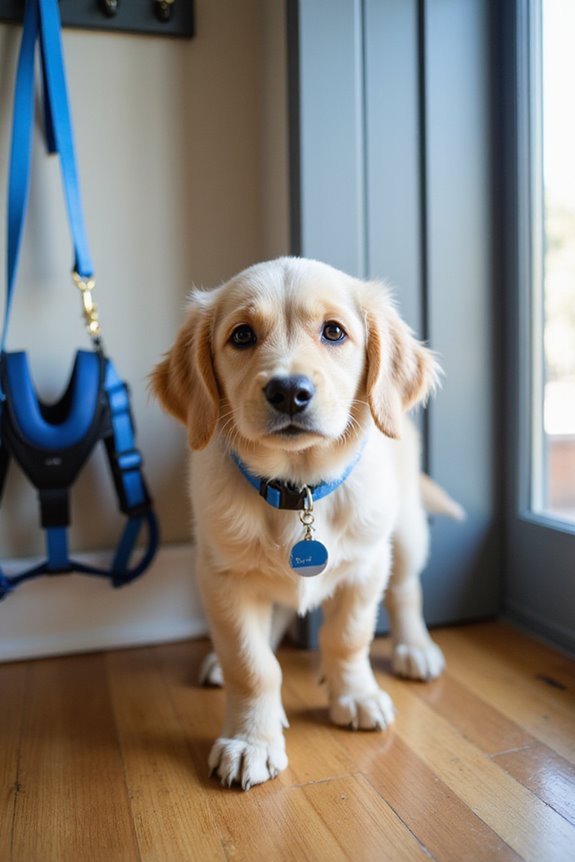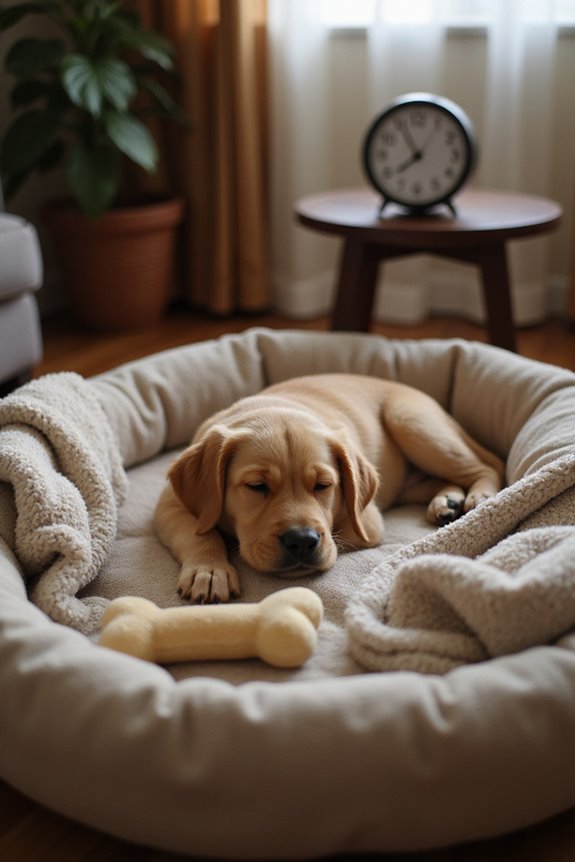When bringing home a new puppy, you’ll need several important supplies for their well-being. Start with containment and safety supplies, such as a sturdy dog crate and exercise pen. Feeding essentials include high-quality puppy food and non-tip bowls. You’ll also need a flat collar or harness that fits properly. Choose a cozy dog bed, and guarantee you have interactive toys for mental stimulation. To fully prepare for your puppy’s arrival, consider exploring additional recommendations and tips.
Key Takeaways
- Provide a secure dog crate or playpen for safe sleep and supervised playtime.
- Establish a consistent feeding schedule with high-quality puppy food and proper feeding bowls.
- Invest in appropriate collars, leashes, and harnesses that fit securely and comfortably.
- Create a cozy sleeping setup with a suitable dog bed and blankets for warmth.
- Include various toys for enrichment, such as chew toys, snuffle mats, and interactive puzzles.
Containment and Safety Supplies
When you bring a new puppy into your home, guaranteeing their safety and containment is essential for both their well-being and yours. Choosing the right containment equipment can greatly impact your puppy’s comfort and your peace of mind. Here’s what to take into account:
- Dog Crate: A secure, enclosed space for sleep or transport.
- Playpen/X-pen: Perfect for supervised indoor or outdoor play.
- Exercise Pen: Offers both activity and rest space.
- Gates: Control access to hazardous areas.
Prioritize safety features like sturdy construction, appropriate sizing, smooth edges without sharp corners, secure latches, and proper ventilation. These will not only support house training but also reduce anxiety by providing a safe environment. Investing in quality containment guarantees your puppy can thrive while staying safe, especially when selecting a durable dog crate to ensure long-lasting security.
Feeding Essentials

After you’ve secured your puppy’s safety and containment, the next step is to focus on their feeding essentials, which are vital for their growth and overall health.
- Puppy Food Selection: Choose complete, commercial puppy food specifically labeled for puppies. Consider your puppy’s breed size and growth rate when selecting food. Avoid artificial additives and look for AAFCO approval. Additionally, consider opting for grain-free dog foods that provide high protein options and support overall health.
- Feeding Schedule: Establish a consistent feeding schedule, typically 3-4 meals daily. Use measuring tools to guarantee accurate portions.
- Feeding Bowls: Opt for sturdy, non-tip, stainless steel or ceramic bowls. Clean these regularly to maintain hygiene.
- Hygiene: Always provide fresh, clean water and avoid human food to keep your puppy’s diet balanced.
These guidelines will support your puppy’s health and well-being.
Collars, Leashes, and Harnesses

Collars, leashes, and harnesses are vital tools for managing your puppy’s behavior and guaranteeing their safety during walks and outings. Selecting the right collar types is important; flat collars are great for everyday use, while martingale collars can prevent escape without choking. For added safety, consider breakaway collars. Harness benefits are significant, especially for strong pullers. Back-clip harnesses reduce neck strain, whereas front-clip harnesses help redirect pulling behavior. When choosing a harness, confirm proper fit to avoid discomfort or chafing. I recommend regularly checking your puppy’s equipment for wear and adjusting when necessary for their growing body. Prioritizing both safety and comfort in these tools will lead to more enjoyable walks and a stronger bond with your new puppy. Additionally, look for harnesses with reflective stitching to enhance visibility during nighttime walks.
Sleeping and Comfort Setup

Once you’ve established the right equipment for walks, it’s time to focus on creating a comfortable sleeping setup for your new puppy. Your puppy’s sleeping arrangements are vital for their well-being, so selecting the right bedding types is essential. Consider the following options:
- Dog Beds: Choose bolster beds for active sleepers or fluffy ones for comfort.
- Elevated Beds: They keep your puppy cool and off the ground.
- Vetbed: A washable, synthetic sheepskin option for ease and comfort.
- Blankets: Ideal for added warmth, especially for ground-level sleepers.
Make sure to gradually introduce them to their crate with comfortable bedding, ensuring it’s large enough for growth. A consistent routine helps establish a sense of security during sleep. Additionally, selecting a bed with orthopedic support can help alleviate potential joint issues as your puppy grows.
Toys and Enrichment

When considering the well-being of your new puppy, providing engaging toys and enrichment activities is essential for their development. Enrichment toys stimulate mental engagement and are crucial for cognitive growth. Here are some key types:
- Treat-dispensing chew toys: Encourage safe chewing and mental engagement.
- Snuffle mats: Promote foraging behavior by hiding treats, stimulating their sense of smell.
- Interactive puzzle toys: Foster problem-solving skills through challenges that reward exploration.
- Hide and seek toys: Inspire searching behaviors that keep them mentally active.
- Slow feeders: Enhance mealtime by promoting slower eating and better digestion.
Incorporating a variety of enrichment toys into your puppy’s routine will provide the necessary mental stimulation, helping prevent boredom and destructive behaviors while supporting their overall development. Additionally, engaging toys can reduce anxiety by alleviating boredom and promoting sustained mental health.
Frequently Asked Questions
How Can I Puppy-Proof My Home Effectively?
When I puppy-proof my home, I focus on furniture protection to prevent tipping and use cord management techniques, like chew-proof tubing. It creates a safe, loving space for my new furry friend to explore.
When Should I Start Training My Puppy?
I believe puppy training should start as soon as you bring your furry friend home. Using positive training techniques early helps build a solid foundation, ensuring their good behavior and happiness in our lives together.
What Vaccinations Does My Puppy Need?
Imagine a shield of protection for your puppy, crafted through careful vaccinations. I’ve learned that following a puppy vaccinations schedule is essential, and I’m aware of potential vaccination side effects too. Let’s keep our fur babies safe together.
How Often Should I Take My Puppy to the Vet?
It’s essential to prioritize my puppy’s wellness with regular vet visits. I take my puppy every 3 to 4 weeks for health checks, vaccinations, and guidance, ensuring we’re on track for a happy, healthy life together.
What Are Signs of Potential Health Issues in Puppies?
I’ve learned that signs like lethargy, changes in puppy behavior, or a loss of appetite could indicate common illnesses. It’s so important to keep an eye on them and get help when needed.

